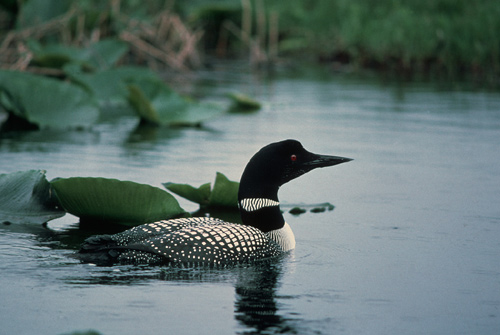Adult common loons are striking black and white birds with red eyes, seen most often floating on the water. Summer plumage consists of a green-glossed black head and neck, black and white lines on the the neck and black and white checkered feathering on the back. The summer beak is very black. In winter the upper feathers are grayish to brown, the bill becomes gray and the throat and underside are white. Loons are large and heavy-bodied birds with large tapered bills. Their legs are set rather far back on the body enabling them to dive extremely well but making walking difficult. They only leave the water to nest and to fly. Their feet are webbed. The adults can weigh between 6 and 9 pounds and have wingspans of about 5 feet.
Loon calls are hauntingly beautiful. In my opinion few things are finer than hearing loons across a lake in the summer. They make mournful wails, and laughing calls, usually at dusk or at night. Click the link under the picture for an example. Loons do not call in the winter.
Common loons summer in northern New England and most of Canada and Alaska. For the winter they move to coastal habitats along the southern Alaskan shoreline, the western eastern and southern coasts of the continental US and the western shores of Mexico.
Some common loons may breed in Connecticut, although most New England loons breed in Maine, Vermont, New Hampshire and central Massachusettes. Common loons are seen in the summer in Connecticut.
Loons take flight from the water. They may form large groups called rafts just prior to their migrations in the fall when they head to winter habitat. Loons are shy and will dive when approached and are easily disturbed while nesting.
Common loons are water birds and live in lakes, estuaries, and reservoirs. They use inland waters in the summer and coastlines more during the winter months. The waterbodies they inhabit must contain plenty of fish and need to be at least 1/4 mile in length to enable loons to take flight. They need a runway.
Common loons eat fish and can dive up to 150 feet to catch them. They also eat crustaceans, mollusks and aquatic insects.
In New England common loons nest in freshwater, more inland habitats or on marshy coasts. The nests are near the water's edge (loons aren't great walkers and need close access to the water) and are often reused year after year. Loons may build a stack of mud and vegetation for a nest, make a scraped-out area in sand, or use a hummock on a stump. Usually 2 green speckled eggs are laid between May and June. Both parents incubate the eggs and care for the chicks which hatch out in late June or early July. The fuzzy black chicks enter the water within a few hours. They can dive and chase tiny fish within 2 days, but their parents guard and feed them for about 3 months. The chicks may rest on their parents' backs in their first few weeks sheltered by parental wings. At the end of summer the young loons are ready to be independent and have their juvenile feathers of brown. The lifespan of common loons is thought to be at least 18 years but maybe as much as 25 years.
